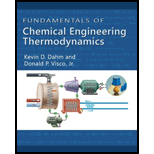
(A)
Interpretation:
The best estimate of the fugacity in the liquid phase at temperature 400 K and pressure 100 bar for benzene.
Concept Introduction:
The expression of the vapor pressure using shortcut equation is,
Here, reduced vapor pressure is
The expression of the vapor pressure is,
The expression of the reduced temperature
Here, system temperature is T.
The expression of the parameter used in calculation of a for Peng-Robinson EOS is,
Here, parameter is
The Poynting equation to calculate the fugacity
Here, molar volume in liquid phase is
(A)
Explanation of Solution
Refer Appendix C.1, “Critical point, enthalpy of phase change, and liquid molar volume”; obtain the properties for different components as in Table (1).
|
Acentric factor |
Critical pressure |
Critical temperature |
Molar volume in liquid phase | |
| 0.210 | 48.95 | 562.05 | 89.41 | |
| 0.3 | 30.25 | 507.60 | 131.59 | |
| Phenol | 0.442 | 61.30 | 694.25 | 87.87 |
Write the expression of the vapor pressure using shortcut equation.
Substitute
Write the expression of the vapor pressure.
Substitute
Thus, the best estimate of vapor pressure at temperature of
Write the expression of the reduced temperature
Substitute
Write the expression of the parameter used in calculation of a for Peng-Robinson EOS.
Substitute
Write the expression of the value of
Substitute
Write the expression of the value of parameter a at the critical point.
Here, gas constant is
Substitute
Write the expression of the parameter
Substitute
Write the expression of the parameter
Substitute
Write the expression of the molar volume
Here, pressure is
Substitute
Write the expression of compressibility factor
Substitute
Write the expression of the dimensionless group that include the Peng-Robinson parameter
Substitute
Write the expression of the dimensionless group that include the Peng-Robinson parameter
Substitute
Write the fugacity of a compound as described by the Peng-Robinson equation.
Here, the fugacity of a liquid or vapor that is at its vapor pressure is
Substitute
Write the Poynting equation to calculate the fugacity
Substitute
Thus, the fugacity in the liquid phase at temperature of
(B)
Interpretation:
The best estimate of the fugacity in the liquid phase at temperature 400 K and pressure 100 bar for n-hexane.
(B)
Explanation of Solution
Substitute
Substitute
Thus, the best estimate of vapor pressure at temperature of
Substitute
Substitute
Substitute
Substitute
Substitute
Substitute
Substitute
Substitute
Substitute
Substitute
Substitute
Substitute
Thus, the fugacity in the liquid phase at temperature of
(C)
Interpretation:
The best estimate of the fugacity in the liquid phase at temperature 400 K and pressure 100 bar for phenol.
Concept Introduction:
The expression of the vapor pressure using Antoine equation is,
Here, vapor pressure is
(C)
Explanation of Solution
Convert the unit of temperature from Kelvin to degree Celsius.
Write the expression of the vapor pressure using Antoine equation.
Refer Appendix E, “Antoine Equations”; obtain the following properties for component 1 and 2 as in Table (1).
| Parameters | Phenol |
| A | 7.1330 |
| B | 1516.79 |
| C | 174.95 |
Substitute
Thus, the best estimate of vapor pressure at temperature of
Assume ideal gas behavior, as the obtained value of pressure is less,
Substitute
Substitute
Thus, the fugacity in the liquid phase at temperature of
Want to see more full solutions like this?
Chapter 8 Solutions
Fundamentals of Chemical Engineering Thermodynamics (MindTap Course List)
 Introduction to Chemical Engineering Thermodynami...Chemical EngineeringISBN:9781259696527Author:J.M. Smith Termodinamica en ingenieria quimica, Hendrick C Van Ness, Michael Abbott, Mark SwihartPublisher:McGraw-Hill Education
Introduction to Chemical Engineering Thermodynami...Chemical EngineeringISBN:9781259696527Author:J.M. Smith Termodinamica en ingenieria quimica, Hendrick C Van Ness, Michael Abbott, Mark SwihartPublisher:McGraw-Hill Education Elementary Principles of Chemical Processes, Bind...Chemical EngineeringISBN:9781118431221Author:Richard M. Felder, Ronald W. Rousseau, Lisa G. BullardPublisher:WILEY
Elementary Principles of Chemical Processes, Bind...Chemical EngineeringISBN:9781118431221Author:Richard M. Felder, Ronald W. Rousseau, Lisa G. BullardPublisher:WILEY Elements of Chemical Reaction Engineering (5th Ed...Chemical EngineeringISBN:9780133887518Author:H. Scott FoglerPublisher:Prentice Hall
Elements of Chemical Reaction Engineering (5th Ed...Chemical EngineeringISBN:9780133887518Author:H. Scott FoglerPublisher:Prentice Hall
 Industrial Plastics: Theory and ApplicationsChemical EngineeringISBN:9781285061238Author:Lokensgard, ErikPublisher:Delmar Cengage Learning
Industrial Plastics: Theory and ApplicationsChemical EngineeringISBN:9781285061238Author:Lokensgard, ErikPublisher:Delmar Cengage Learning Unit Operations of Chemical EngineeringChemical EngineeringISBN:9780072848236Author:Warren McCabe, Julian C. Smith, Peter HarriottPublisher:McGraw-Hill Companies, The
Unit Operations of Chemical EngineeringChemical EngineeringISBN:9780072848236Author:Warren McCabe, Julian C. Smith, Peter HarriottPublisher:McGraw-Hill Companies, The





